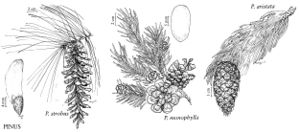Pinus monophylla
in Frémont,Rep. Exped. Rocky Mts. 2: 319, plate 4. 1845.
Trees to 14m; trunk to 0.5m diam., strongly tapering, much branched; crown usually rounded, dense. Bark redbrown, irregularly furrowed or cross-checked, scaly. Branches spreading and ascending, persistent to near trunk base; twigs stout, orangebrown, aging brown to gray, sometimes sparsely puberulent. Buds ellipsoid, light-redbrown, 0.5–0.7cm, resinous; scale margins fringed. Leaves 1 (–2) per fascicle, ascending, persisting 4–6 (–10) years, 2–6cm × 1.3–2 (–2.5) mm, curved, terete (though often 2-grooved), gray-green, all surfaces with stomatal lines, margins entire, apex subulate; sheath 0.5–1cm, scales soon recurved, forming rosette, shed early. Pollen cones ellipsoid, ca. 10mm, yellow. Seed-cones maturing in 2 years, shedding seeds and falling soon thereafter, spreading, symmetric, ovoid before opening, broadly depressed-ovoid to nearly globose when open, 4–6 (–8) cm, pale yellowbrown, nearly sessile; apophyses thickened, slightly raised; umbo subcentral, raised or depressed, nearly truncate, apiculate. Seeds cylindric-ellipsoid; body 15–20mm, gray-brown to brown, wingless. 2n =24.
Habitat: Dry low-montane or foothill pinyon-juniper woodland
Elevation: 1000–2300m
Distribution

Ariz., Calif., Idaho, Nev., Utah, Mexico in Baja California
Discussion
Pinus monophylla hybridizes with P. edulis and P. quadrifolia.
Singleleaf pinyon (Pinus monophylla) is the state tree of Nevada.
Selected References
None.
Lower Taxa
"relatively thin" is not a number.
